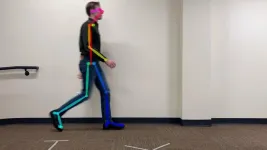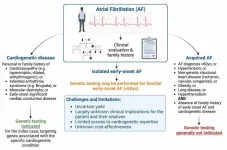(Press-News.org) BALTIMORE, March 27, 2024— Researchers at Kennedy Krieger Institute and Johns Hopkins Medicine have developed a new, accessible approach to analyze a patient’s walking ability and stances more effectively. Following numerous tests, they determined that a simple video recorded on a personal pocket device, such as a smartphone or tablet, can be used to measure gait at a clinical, high-quality level.
Experts say current state-of-the-art approaches to gait analysis are often expensive and inaccessible due to time constraints and extensive efforts required for assessments. However, there is a significant need for this analysis in patients experiencing conditions such as traumatic brain injury, physical injury, or disorders. Through freely available software they created, walking abilities can now be assessed more conveniently, enhancing the comprehensiveness of rehabilitation.
Dr. Ryan Roemmich, a research scientist at the Kennedy Krieger Institute, assistant professor of physical medicine and rehabilitation at the Johns Hopkins University School of Medicine, and co-principal investigator on this project, emphasizes the promising aspect of being able to perform a high-quality gait analysis using nothing more than the smartphone in your pocket.
“We really need better ways of measuring a person’s gait that could be easily accessible to all clinicians and researchers,” Dr. Roemmich said. “Patients that have gait problems resulting from diverse conditions such as Parkinson’s Disease, cerebral palsy, lower extremity injury or amputation, recovery from a stroke, and more, could benefit from this.”
Utilizing cutting-edge software in the assessment is done by clinicians recording a cellphone video that captures the patient's walking pattern from any one of multiple perspectives. The videos could be recorded as the patient walks toward the camera, away from the camera, or from a profile angle depending on the condition being treated. Dr. Roemmich explains that with the ability to record these videos anywhere, they are not limited to testing in a physician’s office.
“It's not uncommon for a clinician to only have access to a long narrow hallway or hospital corridor,” Dr. Roemmich said. “This can be limiting, making a side view recording of a patient impossible. There are now possibilities to record gait patterns on a sidewalk or comfortably inside a hallway within the patient’s home.”
The researchers use algorithms and their software to analyze the recorded data, marking the movement of patients’ knees, ankles, and the length of their steps. Their approach is also based on tracking the size of the person as they appear in the video image. Patients were observed walking on the ground and treadmill.
Dr. Jan Stenum, a research associate at Johns Hopkins University and an additional co-investigator in this research, explains that clinicians will first need to be trained in how to effectively use this technology to produce the best results. But eventually, they want patients to be capable to shoot the videos at home themselves.
“For the best results, all of this is easier to perform in a standardized space by clinicians or researchers,” Dr. Stenum said. “However, we aim to make it fully possible for patients and families to record these videos themselves on their own devices and then send to us for analysis.”
Dr. Roemmich and Dr. Stenum hope that this development will encourage more doctors across the U.S. to investigate similar alternatives when it comes to the medical analysis of a person’s gait.
“This could propel future research into how these technologies can be used in other forms of rehabilitation,” said Dr. Roemmich. “I look forward to fine-tuning our approach and implementing this method for patients who need it most.”
About Kennedy Krieger Institute
Kennedy Krieger Institute, an internationally known, non-profit organization located in the greater Baltimore/Washington, D.C. region, transforms the lives of more than 27,000 individuals a year through inpatient and outpatient medical, behavioral health and wellness therapies, home and community services, school-based programs, training and education for professionals and advocacy. Kennedy Krieger provides a wide range of services for children, adolescents and adults with diseases, disorders or injuries that impact the nervous system, ranging from mild to severe. The Institute is home to a team of investigators who contribute to the understanding of how disorders develop, while at the same time pioneer new interventions and methods of early diagnosis, prevention and treatment. Visit KennedyKrieger.org for more information about Kennedy Krieger.
###
END
A new study led by Michigan State University researcher Peter Williams sheds light on the profound influence of deep geographic isolation on the evolution of mammals. Published in Nature Communications on March 28, the research reveals how long-lasting separation between continents has shaped distinct mammal communities around the globe.
“Today’s ecology was not inevitable. If there were different isolating factors long ago, we might have vastly different ecosystems today,” said Peter Williams, the lead author of the study. Williams is a research ...
The first analysis of how synaptic proteins change during early development reveals differences between mice and marmosets but also what's different in individuals with autism spectrum disorders. The Kobe University findings offer first insights into the mechanism behind synaptic development and open up routes for research on possible treatments.
Given that synapses are the connections between our brain cells, one might think that having as many of these as possible is a good thing. However, primate brains do something unexpected: After early childhood, ...
Lower-income communities across the United States have long been much slower to adopt solar power than their affluent neighbors, even when local and federal agencies offer tax breaks and other financial incentives.
But, commercial and industrial rooftops, such as those atop retail buildings and factories, offer a big opportunity to reduce what researchers call the “solar equity gap,” according to a new study, published in Nature Energy and led by researchers at Stanford University.
“The ...
PHOENIX, Ariz. — March 28, 2024 — Regulators of gene expression are thought to play an outsized role in disorders from cancers to heart disease. But how exactly do variations in gene regulation translate into a disease’s biology?
A team of scientists led by researchers from the Translational Genomics Research Institute (TGen), part of the City of Hope, together with investigators at St. Vincent’s Institute of Medical Research and Vanderbilt University Medical Center, now have a better answer for this question when it comes to pulmonary fibrosis (PF), an incurable respiratory disease.
Their study, published today in Nature Genetics, is the first to look at these ...
PULLMAN, WA -- More than half a million cats in the United States could be at risk of a severe or even fatal neurological reaction to the active ingredient in some top-selling parasite preventatives for felines.
While the ingredient, eprinomectin, which is found in products like NexGard COMBO and Centragard, appears safe and effective for the significant majority of cats when used at label doses, a study conducted by Washington State University’s Program for Individualized Medicine identified a risk of severe adverse effects in cats with the ...
IOP Publishing (IOPP) and the Institute of Physics and Engineering (IPEM) have introduced checks for sex and gender equality for all manuscripts submitted to their jointly published journal Physiological Measurement.
In line with the Sex and Gender Equity in Research (SAGER) guidelines, which were introduced to ensure that sex and gender considerations are appropriately reported in scholarly literature, all research published in Physiological Measurement must declare the sex and gender balance of subject groups. Authors are ...
Dogs’ sensitive noses can detect the early warning signs of many potentially dangerous medical situations, like an impending seizure or sudden hypoglycemia. Now, scientists have found evidence that assistance dogs might even be able to sniff out an oncoming PTSD flashback, by teaching two dogs to alert to the breath of people who have been reminded of traumas.
“PTSD service dogs are already trained to assist people during episodes of distress,” said Laura Kiiroja of Dalhousie University, first author of the paper ...
Dr. Cheol-Woo Ahn, leading a research team at the Department of Functional Ceramics within the Ceramic Materials Division at the Korea Institute of Materials Science(KIMS), has developed the world's first heat dissipation material. This material reduces hydrophilicity through a chemical reaction that forms a nanocrystalline composite layer and increases thermal conductivity by controlling point defects. This process occurs during a simple sintering process that does not require surface treatment. KIMS is a government-funded research institute under the Ministry of Science and ICT.
Conventional ...
Arlington, Va. — March 28, 2024 — A new study published today in the American Journal of Infection Control (AJIC) demonstrates the use of a simple pre-surgical infection prevention protocol to prevent dangerous post-surgical infections. Researchers performed this investigation at the Soroka University Medical Center in Israel.
Surgical site infections (SSIs) are a type of healthcare-associated infection with deadly consequences for some patients. According to the latest data from the Centers for ...
Philadelphia, March 28, 2024 – Although the vast majority of clinicians do not view atrial fibrillation (AF) as a genetic disorder, a White Paper in the Canadian Journal of Cardiology, published by Elsevier, analyzes the current understanding of genetics and the role of genetic testing in AF and concludes there is an increasing appreciation that genetic culprits for potentially life-threatening ventricular cardiomyopathies and channelopathies may initially present with AF.
AF is the most common sustained cardiac arrhythmia and is associated with increased risks of heart failure, stroke, and death. It is ...





